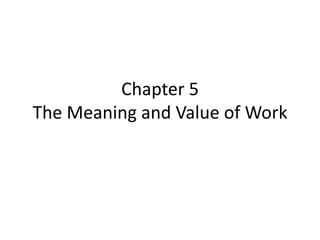
Chapter 5 case study
- 1. Chapter 5 The Meaning and Value of Work
- 2. Discussion Case Social Enterprise and Social Entrepreneurs
- 3. • What makes a career successful • By what criteria would you judge that you’ve had a successful career? • Is it enough to say that you are employed? • Is it important the job be long term and pay a lot • How much is “a lot”? • Is success measured by income? • Would it matter if you were underemployed; that is if your career was not challenging and did not require the knowledge and skills that you acquired during your education? • Does it matter what goods or service your career produced? • Would it matter how well you performed your job-related tasks? • Does it matter the type of work you do and who you worked door? • Does your care serve a purpose?
- 4. • In most discussion about business and ethics: pursuit of profit is at odds with the pursuit of personal and social responsibilities. – Business Ethics: oxymoron – What message sent to employees when the pursuit of profit, the guiding principle of their time at work, is thought to be incompatible with doing the socially responsible thing? – Is it possible to find meaning and value at work if employees are told to check their conscience at the door?
- 5. • Organizations that pursue social ends as the very core of their mission – Non-profit, NGO’s, foundations, professional organizations, schools, colleges, and government agencies. • Social Entrepreneurship or social enterprise: challenges the assumption that one cannot pursue both profit and social causes – Social entrepreneurship differs from work of nonprofit groups such s NGO’s and corporate foundation in that they explicitly seek profit.
- 6. • Social Entrepreneurship: involves the standard entrepreneurial characteristics of innovation, creativity, and risk-taking, but marshals these skills to address social needs. – Entrepreneurs: the first who identify an untapped market and then are creative in developing a means for meeting this demand and are willing to take the risk that their creation will, in fact, satisfy the demand. • Untapped market: social and ethical need such as social justice, environmental protection, educating, health care.
- 7. • Mohammad Yunus (best-known social entrepreneurs): founder of the Grameen Bank in Bangladesh – Economist, US professor, returned to Bangladesh 1970 soon after gained independence from Pakistan. – Contribute to this new country's independence with his expertise in economics – Bangladesh poor country struggling with effect of a harsh famine. – Grameen Bank was born from recognition that very small amounts of capital, loaned directly to poor people at low rates, could have a tremendous positive impact in helping entire villages escape a cycle of poverty. – Grameen Bank’s model; lend small amounts of money directly to the poorest people to help them establish and sustain small businesses.
- 8. • Yonus identified social need: small loans at interest rates small enough to allow craftswomen to escape a cycle of poverty. – Came u with idea of founding a bank specializing in microfinance • Capital raised though donations and grants at the start, but as Grameen’s success grew, all loans are now capitalized through deposits and interest earned from lending. • Bank owned by barrowers, does not require collateral for its loans • Today would be the envy of other banks which didn’t survive the financial crisis • Has issued over $ 8 billion in micro lending loans and has repayment rate of 98 percent • 2006 Yunas awarded Nobel Peace Price
- 9. • Mozilla: company that produced Firefox – A for-profit subsidiary of Mozilla foundation, non profit organization – Describes itself as a global community of thousands who believe in power of technology to enrich people’s lives. – Public benefit organization dedicated not to making money but to improving the way people everywhere experience the Internet. • Work: in the decades after WWII, understood as an industrial model – A career existed in a long-term relationship within a single firm – Employees received: steady and stable employment, secure wages and benefits, and opportunities of promotion within the firm.
- 10. – Employers received benefits of increased productivity created by a stable, experienced, and competent workforce – This model of work served the purposes of both employees and employers. • 1990’s experienced period of economic growth, prosperity fueled by increased worker productivity and extraordinary technological advancements. – Workplace experienced major shifts caused by significant corporate layoffs as witnessed by now words like “downsizing "and “outsourcing” of jobs to cheaper labor markets offshore. • 2008-2009 Economic Recession resulted in higher unemployment rates that economists predict will continue for years as the “new normal”.
- 11. • Social entrepreneurship and social enterprises provide helpful background against which to reflect on the changing nature of work. • Times when employees can no longer count on long-term stable employment from a single local company, – how, if at all can a person find a meaningful and successful career? – Can the workplace provide meaning and purpose, or is better to think of the workplace as capable of providing nothing other than jobs, nothing other than a place where one earns money?